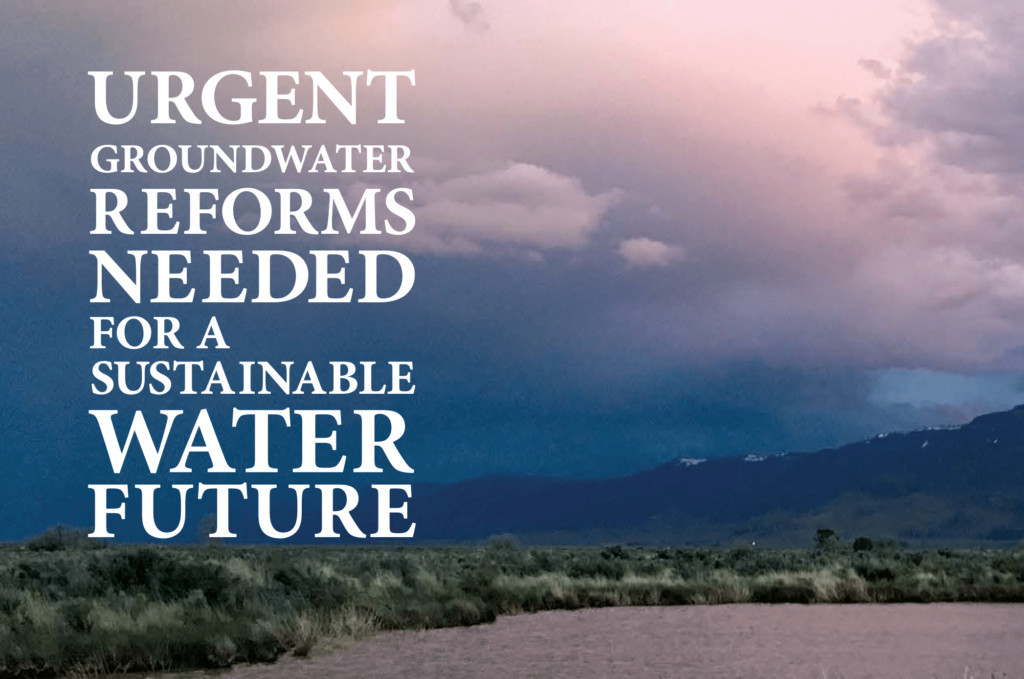By WaterWatch Staff | April 5, 2022 | Instream
WaterWatch works across Oregon in administrative, collaborative, legislative and legal forums to advocate for reforms needed to secure sustainable groundwater management. WaterWatch has identified five critical and urgent reforms needed to put Oregon on a course to manage groundwater sustainably:
1 — Stop issuing permits without adequate information.
Even though groundwater permitting standards require Oregon to find that water is available for the use before issuing a new groundwater permit, in practice, where the state lacks enough data to make that determination — which includes much of Oregon — the Water Resources Department issues the permit. This default-to-yes approach has caused, and continues to cause, huge problems across Oregon. Perhaps most dramatically, in the Harney Basin the agency’s default-to-yes approach caused it to over-allocate groundwater by more than 100,000 acre-feet, resulting in groundwater levels plummeting by more than 100 feet in some areas. This harms ecosystems, rural well users, and senior water rights holders. To ensure groundwater is managed sustainably, when the Water Resources Department lacks data to determine whether or not it has already issued too many groundwater permits, it must default-to-no and deny the new permit.
2 — Immediately cease the “race to the bottom” approach.
Currently, the Water Resources Department requires a senior groundwater user to drill a well deeper in response to declining well levels caused by pumping by junior groundwater users. This race-to-the-bottom approach clearly does not maintain stable groundwater levels, limit pumping to amounts that can be recharged annually, or assure safe and adequate groundwater for drinking. Requiring well deepening in order to chase water to the bottom of the aquifer in response to excessive pumping is antithetical to Oregon’s 1955 Ground Water Act, demonstrating instead a failure to maintain stable groundwater levels. It further fails to assure adequate and safe supplies of drinking water, instead causing great hardships and costs to many rural residential well owners. The race-to-the-bottom approach must stop.
3 — Enforce basic groundwater permit conditions.
When issuing a new groundwater permit in an area where groundwater levels are declining, the Water Resources Department typically issues the permit with a “decline condition,” requiring that groundwater pumping under the permit cease if certain groundwater declines occur. While the agency relies on this condition to justify issuing new permits in areas of concern for groundwater declines, these conditions are not enforced. Enforcing the decline conditions in permits is a critical tool and one the agency must start utilizing to address known groundwater declines.
4 — Revisit antiquated groundwater plans, e.g. let’s not dry up Summer Lake!
In parts of Oregon, the Water Resources Department’s documented plan is to allow unsustainable groundwater pumping to lower the groundwater level to the point that groundwater cannot flow to springs or support plants that rely on groundwater. The reasoning is that if groundwater can no longer ‘escape’ to support these groundwater-dependent ecosystems, it could instead be pumped for irrigation. This outdated approach in these decades-old plans must be changed. The most alarming of these may be the plan to allow groundwater pumping in the Fort Rock area to eventually halt groundwater flow at Ana River Springs, which supplies water to Summer Lake. This would have dire consequences for the Summer Lake Wildlife Area, established in 1944 and managed by the Oregon Department of Fish and Wildlife, and the tens of thousands of waterfowl, shorebirds and other waterbirds that make Summer Lake their home.
5 — Expeditiously fix the system for designating critical groundwater area and regulate over-pumping.
Oregon has the authority to designate areas where groundwater levels are significantly declining and then limit pumping, but has not done so for many years. The Water Resources Department is currently updating its rules to govern the process, but the longer this process is drawn out, more water is being pumped unsustainably from our aquifers. The state must get this system up and running — and implement pumping limits in several places in the state — as fast as possible.
This WaterWatch staff article originally appeared in the April 2022 edition of WaterWatch’s Instream newsletter.

